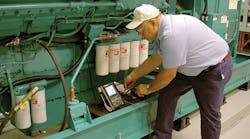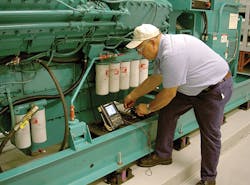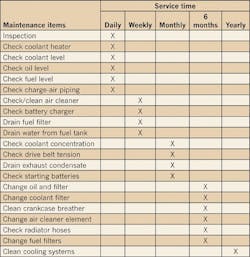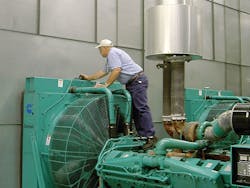Today’s electrical grid delivers reliable electricity to millions of homes and businesses. However, electrical failures that affect large geographic areas do happen on a recurring basis due to hurricanes, floods, or major equipment failures. Local outages that affect smaller numbers of people happen much more often. In fact, in 2012, there were more than 2,800 unplanned power outages in the United States that lasted an average of 2.5 hr. Combined, these affected more than 25 million people, according to Eaton Corp.’s “Blackout Training Annual Report 2012.”
For individual households, such power outages are often just an inconvenience. For hospitals and other health-care facilities, however, they can be life-threatening. For businesses like data centers, these outages can be extremely costly. A recent study by the Department of Energy found that financial losses from power outages at data centers ranged from $20,000 to $2 million per occurrence. Other mission-critical facilities at risk include government offices, police, fire, airports, and water/sewage treatment plants.
Having a well-designed and well-maintained standby power system is the best protection against utility power outages. According to the industry group Diesel Technology Forum, diesel-powered generators provide the most reliable form of emergency backup power, and can start/assume full-rated load in less than 10 sec. While backup generators typically can go 30,000 hr or more between major overhauls, even the best system needs to be exercised and maintained on a regular basis to make sure it operates properly when needed. When standby generators fail to start or perform as designed, it is usually due to faulty maintenance procedures or neglect. In fact, the top three reasons standby generators fail to automatically start or run are:
• The generator START switch was left in the OFF position instead of AUTO.
• Starting batteries were dead or insufficiently charged.
• The fuel filter was clogged due to old or contaminated fuel.
All of these common issues can be eliminated with a regular generator maintenance routine performed by properly trained personnel. Facilities with qualified in-house technical
personnel often can perform required preventive maintenance on diesel generators. Other facility managers prefer to contract with a local service provider or power system distributor for regular maintenance service, especially if they have generators in multiple locations.
Following is a list of maintenance procedures that need to be performed on a regular basis. In addition to these checks, exercising the power system under load on a weekly or monthly basis ensures that the generator set and its system of controls and transfer switches is operating as designed.
Preventive maintenance
Because of the durability of diesel engines, most maintenance is preventive in nature and consists of the following operations:
• General inspection
• Lubrication service
• Cooling system service
• Fuel system service
• Servicing and testing starting batteries
• Regular engine exercise
It is generally a good idea to establish and adhere to a schedule of maintenance /service based on the specific power application and the severity of the environment. For example, if the generator set will be used frequently or subjected to extreme operating conditions, the recommended service intervals should be shortened accordingly. Some of the factors that can require more frequent maintenance include:
• Using the diesel generator set for continuous duty (prime power)
• Extreme ambient temperatures
• Exposure to weather
• Exposure to salt water
• Exposure to dust, sand, or other airborne contaminates
If the generator set will be subjected to some or all of these extreme operating conditions, it is best to consult with the engine manufacturer to develop an appropriate maintenance schedule. The best way to keep track of maintenance intervals is to use the running-time meter on the generator set to keep an accurate log of all services performed. This log also will be important for warranty support. The Table shows a typical diesel engine maintenance schedule for generator sets.
General inspection
When the generator set is running, operators need to be alert for mechanical problems that could create unsafe or hazardous conditions. Following are several areas that should be inspected frequently to maintain safe and reliable operation.
• Exhaust system: With the generator set operating, inspect the entire exhaust system, including the exhaust manifold, muffler, and exhaust pipe. Check for leaks at all connections, welds, gaskets, and joints — and make sure that the exhaust pipes are not heating surrounding areas excessively. Repair any leaks immediately. Check for excessive smoke upon starting: It can indicate possible performance and air quality issues that may require immediate attention.
• Fuel system: With the generator set operating, inspect the fuel supply lines, return lines, filters, and fittings for cracks or abrasions. Make sure the lines are not rubbing against anything that could cause an eventual failure. Repair any leaks or alter line routing to eliminate wear immediately.
• DC electrical system: Check the terminals on the starting batteries to make sure the connections are clean and tight. Loose or corroded connections create resistance, which can hinder starting.
• Engine: Monitor fluid levels, oil pressure, and coolant temperatures frequently. Most engine problems give an early warning. Look and listen for changes in engine performance, sound, or appearance that will indicate that service or repair is needed. Be alert for misfires, vibration, excessive exhaust smoke, decreases in power, or increases in oil or fuel consumption.
• Control system: Inspect the control system regularly, and make sure it is logging data properly during engine exercise. Be sure to return the control system back to normal automatic standby (AUTO) when testing and maintenance are completed.
Lubrication service
Check the engine oil level when the engine is shut down at the interval specified in the Table. For accurate readings on the engine’s dipstick, shut off the engine and wait approximately 10 min. to allow the oil in the upper portions of the engine to drain back into the crankcase. Follow the engine manufacturer’s recommendations for API oil classification and oil viscosity. Keep the oil level as near as possible to the “full” mark on the dipstick by adding the same quality and brand of oil.
Change the oil and filter at the intervals recommended in the Table. Check with the engine manufacturer for procedures for draining the oil and replacing the oil filter. Used oil and filters must be disposed of properly to avoid environmental damage or liability.
Cooling system service
Check the coolant level during shutdown periods at the interval specified in the Table. Remove the radiator cap after allowing the engine to cool, and, if necessary, add coolant until the level is about 3/4 in. below the radiator cap’s lower sealing surface. Heavy-duty diesel engines require a balanced coolant mixture of water, antifreeze, and coolant additives. Use the coolant solution recommended by the engine manufacturer.
Inspect the exterior of the radiator for obstructions, and remove all dirt or foreign material with a soft brush or cloth. Use care to avoid damaging the fins. If available, use low-pressure compressed air or a stream of water in the opposite direction of normal air flow to clean the radiator. Check the operation of the coolant heater by verifying that hot coolant is being discharged from the outlet hose.
Fuel system service
Diesel is subject to contamination and deterioration over time, and one reason for regular generator set exercise is to use up stored fuel before it degrades. In addition to other fuel system service recommended by the engine manufacturer, the fuel filters should be drained at the interval indicated in the Table. Water vapor accumulates and condenses in the fuel tank — and also must be periodically drained from the tank along with any sediment present. Bacterial growth in diesel fuel can be an issue in warm climates. Consult the generator set manufacturer or dealer for recommendations on treating stored fuel with a biocide. Regular testing and fuel polishing may be required if the fuel is not used and replenished in three to six months.
The charge-air cooler piping and hoses should be inspected regularly for leaks, holes, cracks, or loose connections. Tighten the hose clamps as necessary. In addition, inspect the charge-air cooler for dirt and debris that may be blocking the fins. Check for cracks, holes, or other damage.
The engine air intake components should be checked at the interval indicated in the Table. The frequency of cleaning or replacing air cleaner filter elements is primarily determined by the conditions under which the generator set operates. Air cleaners typically contain a paper cartridge filter element that can be cleaned and reused if not damaged.
Starting batteries
Weak or undercharged starting batteries are a common cause of standby power system failures. Even when kept fully charged and maintained, lead-acid starting batteries are subject to deterioration over time and should be replaced approximately every 24 to 36 months — or when they no longer hold a proper charge. NiCad starting batteries require less maintenance than lead-acid and are often used in mission-critical applications. However, they are also subject to deterioration and need to be regularly tested under load. See the Table for the recommended inspection interval for lead-acid batteries and the charging system.
• Testing batteries: Merely checking the output voltage of the batteries is not indicative of their ability to deliver adequate starting power. As batteries age, their internal resistance to current flow goes up, and the only accurate measure of terminal voltage must be done under load. On some generators, this diagnostic test is performed automatically each time the generator is started. On other generator sets, use a manual battery load tester to verify the condition of each starting battery.
• Cleaning batteries: Keep the batteries clean by wiping them with a damp cloth whenever dirt appears excessive. If corrosion is present around the terminals, remove the battery cables and wash the terminals with a solution of baking soda and water (¼ lb baking soda to 1 quart of water). Be careful to prevent the solution from entering the battery cells, and flush the batteries with clean water when finished. After replacing the connections, coat the terminals with a light application of petroleum jelly.
• Checking specific gravity: In open-cell lead-acid batteries, use a battery hydrometer to check the specific gravity of the electrolyte in each battery cell. A fully charged battery will have a specific gravity of 1.260. Charge the battery if the specific gravity reading is below 1.215.
• Checking electrolyte level: In open-cell lead-acid batteries, check the level of the electrolyte at least every 200 hr of operation. If low, fill the battery cells to the bottom of the filler neck with distilled water.
Generator set exercise
Generator sets on continuous standby must be able to go from a cold start to being fully operational in a matter of seconds. This can impose a severe burden on engine parts. However, regular exercising keeps engine parts lubricated, prevents oxidation of electrical contacts, uses up fuel before it deteriorates, and, in general, helps provide reliable engine starting. Exercise the generator set at least once a month for a minimum of 30 min. loaded to no less than one-third of the nameplate rating. Periods of no-load operation should be held to a minimum because unburned fuel tends to accumulate in the exhaust system. Whenever possible, test the system with actual building loads in order to exercise the automatic transfer switches and verify performance under real-world conditions. If connecting to the normal load is not convenient for test purposes, the best engine performance and longevity will be obtained by connecting it to a load bank of at least one-third the nameplate rating. Be sure to return the generator control to AUTO at the conclusion of any maintenance.
The backup plan
Although the United States enjoys high levels of reliable electrical service, utility outages happen often enough to require mission-critical facilities to have standby power systems. Preventive maintenance for diesel engine generators plays a critical role in maximizing the reliability of these standby systems and reducing the severe financial and life-safety risks associated with the loss of power. Financial losses from just a single data center outage can cost upward of $2 million in lost revenue. Preventive maintenance also minimizes the need for repairs and reduces equipment life cycle costs. By following generally recognized diesel maintenance procedures and application-specific manufacturer recommendations, facilities can be assured that their standby power systems will start and run when needed.
Kovach is operations manager for Cummins Power Generation’s PowerCare maintenance program, Minneapolis. He can be reached at [email protected].






